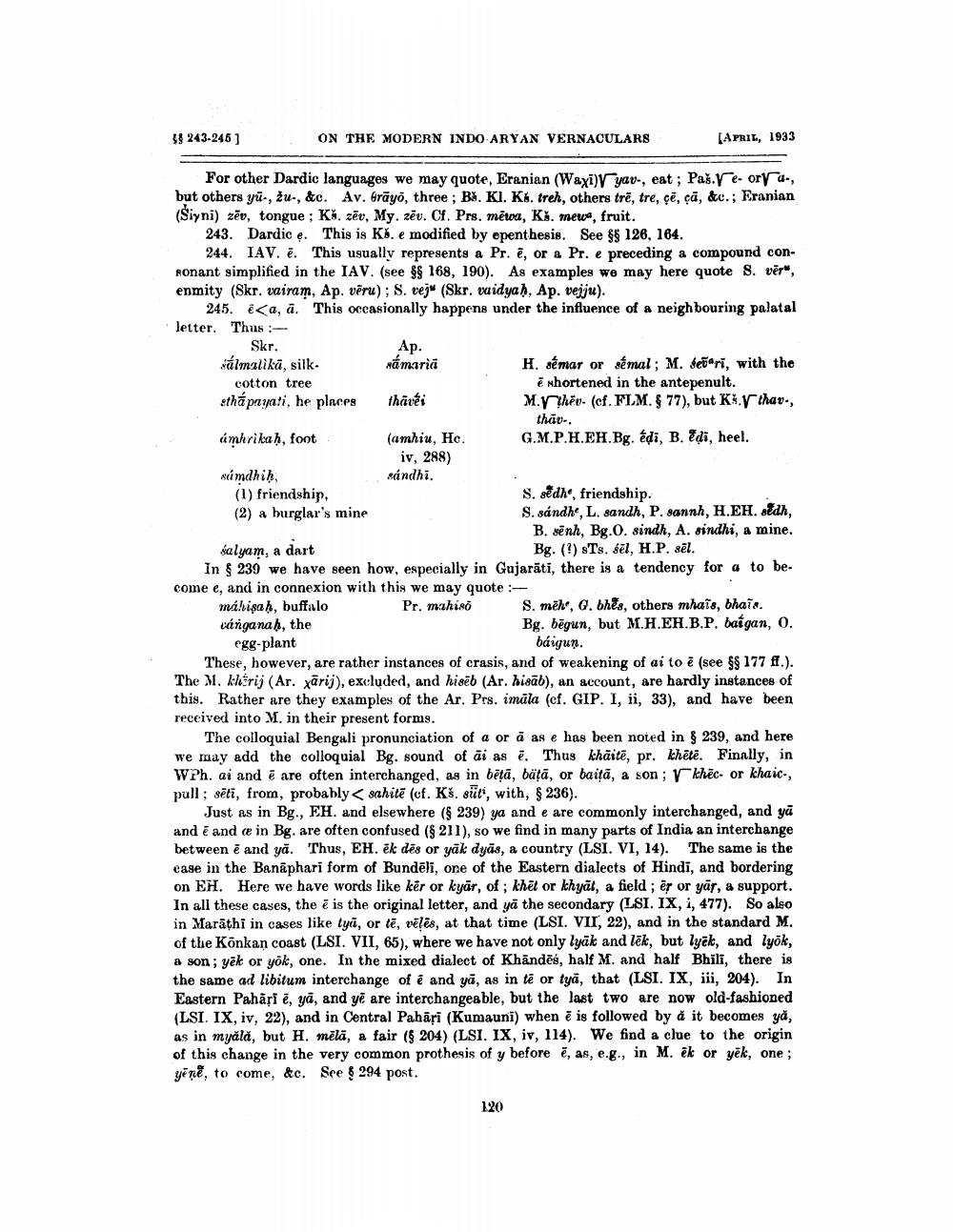________________
$9 243-246)
ON THE MODERN INDO ARYAN VERNACULARS
(APRIL, 1933
Ap.
For other Dardic languages we may quote, Eranian (WaxTV yav-, eat; Paš. Ve or u., but others yū., žu-, &c. Av. Grāyo, three; B. Kl. Kb. treh, others trē, tre, çē, cā, &c.; Eranian (Siyni) zēv, tongue : Ks. zēv, My. zēv. Cf. Prs, mēwa, Ks. mewa, fruit.
243. Dardice. This is K. e modified by epenthesis. See $8 126, 164.
244. IAV. ē. This usually represents a Pr. ē, or a Pr. e preceding a compound consonant simplified in the IAV. (see $$ 168, 190). As examples we may here quote 8. vēr", enmity (Skr. vairam, Ap. vēru); S. vej" (Skr. vidyaḥ, Ap. vejju).
245. éca, a. This occasionally happens under the influence of a neighbouring palatal letter. Thus :
Skr. válmalikā, silk. námaria
H. démar or smal; M. Gebari, with the cotton tree
ē shortened in the antepenult. ethá payati, he places thāvéi
M. thêv(cf. FLM. & 77), but K. thav.,
thit-. ámhrikah, foot
(amhiu, He. G.M.P.H.EH.Bg. édi, B. &di, heel.
iv, 288) sumdhih,
sandhi. (1) friendship,
S. sedh, friendship. (2) a burglar's mine
S. sándh, L. sandh, P. sannh, H.EH. sedh.
B. sēnh, Bg.O. sindh, A. sindhi, a mine. salyam, a dart
Bg. (?) sTs. sēl, H.P. sēl. in $ 239 we have seen how, especially in Gujarāti, there is a tendency for a to become e, and in connexion with this we may quote : mahişah, buffalo
Pr. m:this S. mëhs, G. bhês, others mhais, bhaie. váñganah, the
Bg. bēgun, but M.H.EH.B.P, bai gan, O. egg-plant
báigun. These, however, are rather instances of crasis, and of weakening of ai to ē (see $$ 177 ff.). The M, klerij (Ar. gārij), excluded, and hisēb (Ar. hisāb), an account, are hardly instances of this. Rather are they examples of the Ar. Prs. imāla (cf. GIP. I, ii, 33), and have been received into M. in their present forms.
The colloquial Benguli pronunciation of a or à as e has been noted in $ 239, and here we may add the colloquial Bg. sound of ai as ē. Thus khāitē, pr. khētë. Finally, in WPh. ai and ē are often interchanged, as in bētā, bäļā, or baitā, a son; rkhēc. or khaic, pull; sēti, from, probably < sahitē (cf. Kš. süt, with, $ 236).
Just as in Bg., EH. and elsewhere ($ 239) ya and e are commonly interchanged, and yā and é and ce in Bg. are often confused (211), so we find in many parts of India an interchange between 7 and yā. Thus, EH. ek dēs or yāk dyās, a country (LSI. VI, 14). The same is the case in the Banāphari form of Bundēli, one of the Eastern dialects of Hindi, and bordering on EH. Here we have words like kêr or kyār, of; khēt or khyāt, a field ; ēr or yār, & support. In all these cases, the ē is the original letter, and ya the secondary (LSI. IX, i, 477). So also in Marathi in cases like lya, or tē, vēlēs, at that time (LSI. VII, 22), and in the standard M. of the Könkan coast (LSI. VII, 65), where we have not only lyāk and lēk, but lyck, and lyök, a son; yēk or yök, one. In the mixed dialect of Khāndēs, half M. and half Bhili, there is the same ad libitum interchange of é and yā, as in tē or tyä, that (LSI. IX, iii, 204). In Eastern Pahari ē, yā, and yē are interchangeable, but the last two are now old-fashioned (LSI. IX, iv, 22), and in Central Pahāri (Kumauni) when ő is followed by a it becomes ya, as in myălă, but H. mēlā, a fair ($ 204) (LSI. IX, iv, 114). We find a clue to the origin of this change in the very common prothesis of y before 7, as, e.g., in M. ek or yēk, one; yêrê, to come, &c. See $294 post.
120




